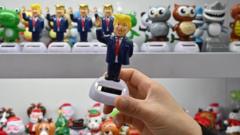The trade conflict between the US and China continues to intensify, with significant tariffs imposed that shake global markets and apprehend consumers. As China navigates the pressure from US tariffs, President Xi Jinping's administration showcases a range of strategies that could shift the dynamics of this economic battle. Below, we explore five key assets that China possesses in this high-stakes trade war.
China's Strategic Tools in the Ongoing US Trade War

China's Strategic Tools in the Ongoing US Trade War
As tensions escalate, China wields significant resources to counteract US tariffs and maintain its economic standing.
China's Ability to Endure Economic Strain
China's position as the second-largest economy grants it a better capacity to withstand the ramifications of tariffs compared to smaller nations. With a sprawling population exceeding a billion, it has the potential to redirect the pressure from exports to domestic consumption. Despite current challenges in consumer spending, President Xi's government could activate a range of incentives, reinforcing the economy. Experts suggest that China’s leadership might be willing to absorb short-term pain to resist what they frame as aggressive US policies. Unlike the US political landscape, China’s authoritarian regime lacks immediate electoral pressures, which allows it to take a long-term view on economic challenges amidst growing public discontent concerning issues like job loss and housing instability.
Investment in Emerging Technologies
China is actively transforming its economy by investing in sophisticated industries, pivoting from merely being the world's factory to leading in high-tech sectors. Under President Xi, strategic investments in everything from artificial intelligence to renewable energy illustrate China's ambition for technological supremacy. Notable examples include domestic competitors like BYD, which surpassed Tesla as the top electric vehicle maker last year, and advanced AI developments. While US firms like Apple seek to diversify their supply chains away from China, they face hurdles in replicating China's unmatched infrastructure and expert labor force. This long-term commitment to innovation positions China favorably in this trade conflict.
Shifting Trade Partnerships
The trade dynamics are also evolving as China seeks to reinforce its global presence beyond reliance on the US. Initiatives like the Belt and Road Initiative aim to strengthen ties with countries in Southeast Asia, Africa, and Latin America, effectively solidifying alternative trade networks. Historically reliant on American agricultural products such as soybeans, China has diversified, sourcing more from Brazil and significantly reducing dependency on US imports. This shift not only enhances China's food security but also repositions it in the global trading landscape, now establishing Southeast Asia as its largest trading partner.
Understanding US Economic Vulnerabilities
The recent experience of the US government bond market suggests that economic confidence can be fragile. Former President Trump’s initiatives to impose tariffs prompted noticeable sell-offs in Treasuries, highlighting the potential financial risks associated with aggressive trade tactics. Reflecting on past moves, experts argue that China may possess leverage through its substantial holdings in US bonds, amounting to approximately $700 billion. However, this comes with risks for China itself, which could face significant financial setbacks if aggressive measures are employed, as it risks destabilizing its currency's value.
Leverage Through Rare Earths
Lastly, China maintains a pivotal role in the global trade of rare earth elements, essential for producing advanced technologies and military equipment. With a staggering 92% control over the refining processes for these elements, any restrictions China imposes could have far-reaching impacts on industries reliant on these critical materials, including automotive and defense. Following the imposition of tariffs, China has already enacted restrictions on several rare earths, showcasing its ability to utilize this advantage strategically in the trade war.
In conclusion, as the trade war with the US unfolds, China remains equipped with multiple strategies that enhance its resilience and could steer the outcome in its favor. The focus on self-sufficiency, technological advancement, and alternative global partnerships add layers of complexity to this ongoing economic confrontation.
China's position as the second-largest economy grants it a better capacity to withstand the ramifications of tariffs compared to smaller nations. With a sprawling population exceeding a billion, it has the potential to redirect the pressure from exports to domestic consumption. Despite current challenges in consumer spending, President Xi's government could activate a range of incentives, reinforcing the economy. Experts suggest that China’s leadership might be willing to absorb short-term pain to resist what they frame as aggressive US policies. Unlike the US political landscape, China’s authoritarian regime lacks immediate electoral pressures, which allows it to take a long-term view on economic challenges amidst growing public discontent concerning issues like job loss and housing instability.
Investment in Emerging Technologies
China is actively transforming its economy by investing in sophisticated industries, pivoting from merely being the world's factory to leading in high-tech sectors. Under President Xi, strategic investments in everything from artificial intelligence to renewable energy illustrate China's ambition for technological supremacy. Notable examples include domestic competitors like BYD, which surpassed Tesla as the top electric vehicle maker last year, and advanced AI developments. While US firms like Apple seek to diversify their supply chains away from China, they face hurdles in replicating China's unmatched infrastructure and expert labor force. This long-term commitment to innovation positions China favorably in this trade conflict.
Shifting Trade Partnerships
The trade dynamics are also evolving as China seeks to reinforce its global presence beyond reliance on the US. Initiatives like the Belt and Road Initiative aim to strengthen ties with countries in Southeast Asia, Africa, and Latin America, effectively solidifying alternative trade networks. Historically reliant on American agricultural products such as soybeans, China has diversified, sourcing more from Brazil and significantly reducing dependency on US imports. This shift not only enhances China's food security but also repositions it in the global trading landscape, now establishing Southeast Asia as its largest trading partner.
Understanding US Economic Vulnerabilities
The recent experience of the US government bond market suggests that economic confidence can be fragile. Former President Trump’s initiatives to impose tariffs prompted noticeable sell-offs in Treasuries, highlighting the potential financial risks associated with aggressive trade tactics. Reflecting on past moves, experts argue that China may possess leverage through its substantial holdings in US bonds, amounting to approximately $700 billion. However, this comes with risks for China itself, which could face significant financial setbacks if aggressive measures are employed, as it risks destabilizing its currency's value.
Leverage Through Rare Earths
Lastly, China maintains a pivotal role in the global trade of rare earth elements, essential for producing advanced technologies and military equipment. With a staggering 92% control over the refining processes for these elements, any restrictions China imposes could have far-reaching impacts on industries reliant on these critical materials, including automotive and defense. Following the imposition of tariffs, China has already enacted restrictions on several rare earths, showcasing its ability to utilize this advantage strategically in the trade war.
In conclusion, as the trade war with the US unfolds, China remains equipped with multiple strategies that enhance its resilience and could steer the outcome in its favor. The focus on self-sufficiency, technological advancement, and alternative global partnerships add layers of complexity to this ongoing economic confrontation.




















